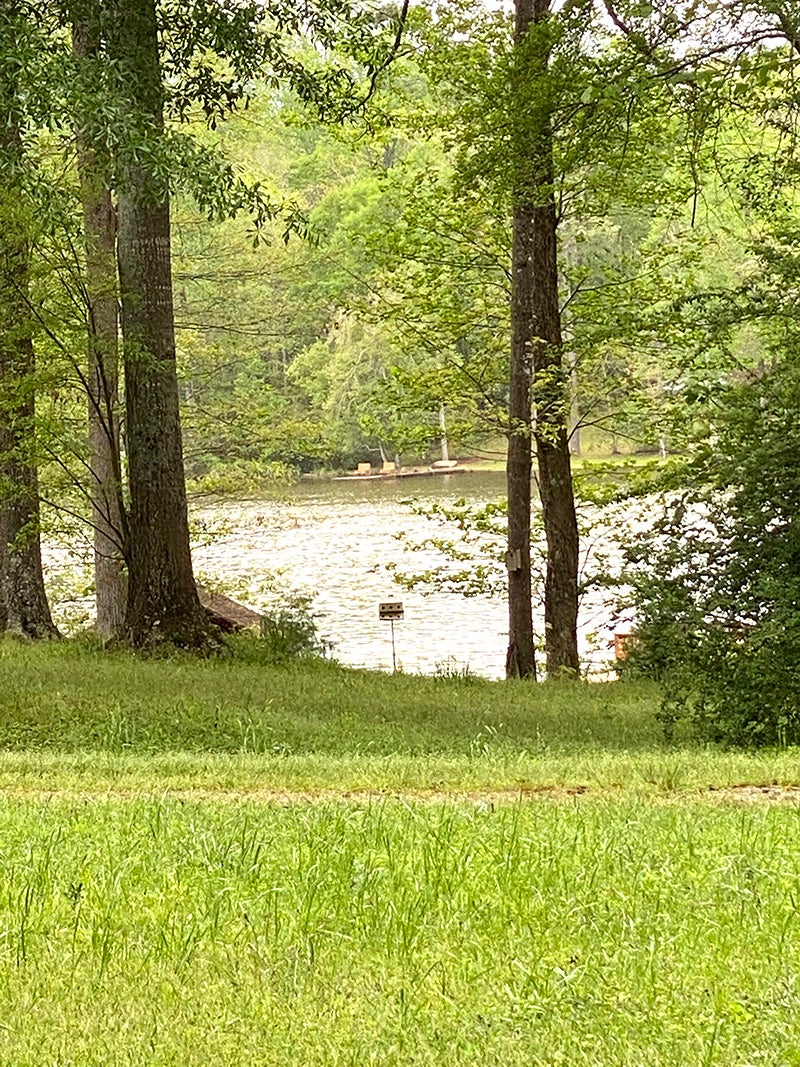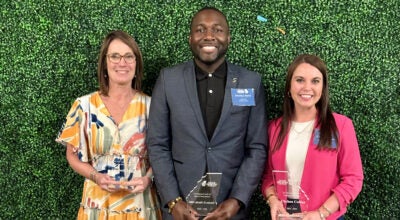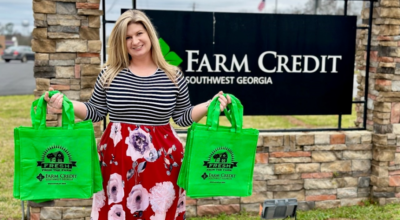Statham Lake residents speak out against rezoning 60 acres
Published 7:40 am Thursday, April 15, 2021

- View from the north end of Statham Lake as seen from East Shore Dr. This area is very close to the 60 acres of property that Inman Solar is requesting to be rezoned so the company can build a solar farm on that property.
|
Getting your Trinity Audio player ready...
|
AMERICUS – At the Sumter County Board of Commissioners’ April work session Tuesday, April 13, two public hearings were held. The first one was to consider a request from Inman Solar Incorporated, a solar company based out of Atlanta, to rezone 60 acres of property in the Statham Lake area from R-1 (Residential) to I-2 (Heavy Industrial) for the purpose of installing a ground-mounted solar farm in the area. The second public hearing was held to consider a request from Inman Solar to obtain a Conditional Use Permit from the county for the construction of a 48-acre solar farm. The property is owned by Sue Statham and it is located off U.S. Highway 19 in Americus.
According to a zoning code laid out by the county, the purpose of zoning a piece of property as R-1 is to encourage the construction of single-family dwellings and prohibit commercial use on that property, which would interfere with the maintenance of single-family dwellings and discourage significant traffic. It would also add additional requirements for public services. This code also states that the purpose of industrial zoning, or I-2, is to provide for the development of commercial/industrial establishments. Typical uses for property that is zoned as I-2 include manufacturing, assembling and fabricating.
The code also states that reasonable regulations can be placed on these areas as to not cause adverse effects on residential or other commercial properties and that the I-2 designation is designed for firms that process raw materials, store toxic substances, require substantial quantities of water or engage in slaughtering animals. Other permitted uses for properties designated as I-2 include using them as junk yards, manufacturing, receiving towers, smelting and meat packing.
On Thursday, March 25, the Sumter County Planning and Zoning Commission (SCPZC) held a public hearing to discuss the rezoning of this 60-acre property in the vicinity of Statham Lake. Inman Solar would like to see this property rezoned from R-1 to I-2 so that it can build a solar farm on it.
Attorneys for both Inman Solar and the Statham Lake residents made their cases for and against the rezoning of this property, but in the end, the SCPZC voted 3-1 in favor of rezoning the property from R-1 to I-2. It was a decision that disappointed many of the residents.
Now that the SCPZC has made its decision, the matter has been submitted before the Sumter County Board of Commissioners (SCBOC) and it was discussed at length during the two public hearings that took place during its work session this past Tuesday. The work session was held virtually via Zoom due to the COVID-19 Pandemic.
In making his case as to why 60 acres of the property should be rezoned to I-2 so that the solar farm can be constructed, Steve Chiariello of Inman Solar told the BOC that the site on which the proposed solar farm is to be built will be inspected to meet all of the national electrical codes and local ordinances and that the company uses UL-Certified equipment. “The system is quiet. There’s no glare. There’s no emissions and there’s no traffic to and from the site once it’s constructed. We cut the grass about once a month,” said Chiariello to the BOC. Chiariello went on to say that the Georgia Environmental Protection Division and the Corps of Engineers review almost every project in the state for environmental concerns. He told the BOC that he could present to them a study done by North Carolina State University that addresses the compatibility of solar farms with agricultural sites and shows that there is no contamination from solar farms on these agricultural sites.
Chiariello went on to say that solar project is good for the county in that it will provide approximately $25,000.00 of tax revenue from this solar project in Year One without putting any kids in school or otherwise, using county services. “Inman Solar and the Stathams have no interest in doing anything industrial on this site whatsoever,” said Chiariello.
BOC Chairman Mark Waddell asked if anyone else would like to speak in favor of the land being rezoned for the solar farm’s construction. Nathan Peck, who lives in the Statham Lake area, stated that he went out to the site on Sunday to attend Inman Solar’s Open House and said that the site is isolated and concealed and that he has provided a letter of support. “I don’t understand the property values. Nobody will see this thing,” said Peck. “I’ve actually never been back there before and had trouble finding it.” Peck went on to say that he believes in solar technology and the cleanliness of it. “I think it’s incumbent upon the county and it’s a benefit to the citizens. We need to adopt these projects that help evolve the county,” said Peck. He went on to say that his bigger concern was the industrial zoning and that, in his opinion, the county needs to resolve that issue. He added that he believes that the developer involved in this has “bent over backwards” in terms of keeping the footprint very small to where it’s still agriculture that would affect any residence.
Susan Crenshaw, the daughter of Su Statham, stated that she lives in the neighborhood and is in favor of the solar farm being constructed. “We want to preserve the beauty of the pasture and that’s why we chose to put the solar panels where no one can see it from Statham Lake and other homes that are around that area,” said Crenshaw. “We plan to keep the farm for many generations and we would never allow industry on it.” Crenshaw went on to say that she feels that solar panels are the future and that she and her family feel that they are being good neighbors by bringing it to a secluded part of their farm.
While there were two residents that were in favor of the solar farm’s construction, several more Statham Lake area residents spoke out against it.
Ben Asnley stated that while he doesn’t currently live in the area, he owns four lots on Statham Lake and that the solar farm would be located right behind those lots. “The bottom comes through from the area and if there’s any sediment or erosion, it’s going to come right through the area where my lots are,” said Ansley. Ansley went on to say that his grandfather, Fred Statham, started the subdivision and at one time was a county commissioner. He added that Mr. Statham put covenants in place to protect the investments of the residents in the neighborhood so that the value of their properties would not be harmed.
“He wouldn’t even let us ride motorcycles out there because we would tear up the ground,” said Ansley. He went on to say that if the habitat that is located where the streams are is destroyed, it will never come back no matter what one tries to do.
“Any sediment that travels down in the areas from the solar farm, the silt is going to go through my lots and then on to Lake Statham,” said Ansley. “I do dirt work. I know how hard it is. Once you disturb and area, it will take you over a year to get the grass back to where you don’t have erosion problems.”
Ansley concluded his statement by saying that he is totally against it and that the property values will be driven down on the lots that border the solar farm. He also added that his grandfather would not even allow someone to build a log cabin on the property because he didn’t want the adjacent properties to be devalued.
“He was worried about hurting other people’s investment,” said Ansley. “Usually, anybody that’s got a house, that’s their retirement and their investment for the end of their life. You don’t want to drive the values down. I’m totally against it, as I know he would have been,” Ansley continued.
Another Statham Lake resident, Johnny Shiver, stated that his wife owns property in the area and that he owns 299 acres that directly touches that property. Shiver stated that he has spent much time, money, effort, energy, blood, sweat and tears to keep his property in a pristine condition. “It’s big pine trees. It’s clean. There’s no trash. There’s no garbage. It’s a pristine hunting track,” said Shiver. “It would sell for a lot of money as a pristine, secluded hunting track. This property (on which the solar farm is built) will devalue my property.”
Shiver went on to say that he and a partner of his from Lee County have built houses together and have made sure that those houses and the lots on which they are built are in protected areas with residential all around them because he knows that industrial and commercial-zoned property that is located next to prime R-1 real estate will devalue that real estate property. “I have personally talked to four or five realtors in town. They will not come on this and speak and they have said that they don’t like it. It’s crazy and you should never do it,” said Shiver. He went on to say that both his property and the property his wife owns is surrounded by several other R-1 residential properties and that there isn’t a solar farm this small that will effect this many people. In other words, in Shiver’s opinion, this proposed solar farm will affect a lot of people in a negative way. “You are effecting about 40 people or more with a small 20-acre farm,” said Shiver.
Shiver added in his statement that Steve Chiariello of Inman Solar came to meet with him and told him that “He would not blame me if the shoe was on the other foot.” On the company’s website: www.inmansolar.com, it says that they have built 116 commercial solar photovoltaic systems throughout the U.S., with most of them being in the Southeast. Shiver pointed out this fact, but added that the company now operates “several.” “Their mission statement, or what they say they’re about, is selling to business owners and investors,” said Shiver. “It’s all about investors investing in solar energy. I like Steve. He’s a nice guy. I don’t blame him for trying to make a buck. No problem. The problem is they are going to get this thing up and running and then they’re going to sell it and they’re going to be gone. That’s the history of a lot of these solar companies.” Shiver added that because of this, he and his fellow residents will be stuck with this problem for 20 to 30 years. Shiver also added that the solar farm can be seen from his wife’s house and that it is not completely hidden from everybody in sight.
He continued by stating that if one puts 20 acres of hard surface material on a farm, the water will run off those 20 acres. “In the city, I pay, at Shiver Lumber, a storm water fee because of the hard surface and the metal roofs I have,” said Shiver. “It’s not going to absorb ground. The water is running off. It’s coming toward my house. It’s going toward this property. It’s going into Statham Lake and God forbid it goes in my well. I’m just going to let you know this is totally out of character for a little bitty solar farm to effect so many people,” Shiver continued. He concluded by exhorting the SCBOC to protect the people of the Statham Lake neighborhood by not allowing the land to be rezoned so that the solar farm can be built there and to leave the land under R-1 status.
Shiver’s wife, Carol Shiver, also spoke out against the rezoning of the land and emplored the SCBOC to not ignore the concerns of several residents for the purpose of favoring one person’s desire. She also stated that if a solar company can build a solar farm on these 60 acres of land, what will stop it from doing it in other places in Sumter County.
Several other Statham Lake neighborhood residents spoke out against the rezoning of the land and gave their reasons for it, such as concerns over property values going down. One of those residents, Bill Naismith, suggested that instead of building the solar farm in the Statham Lake area, it should be built on land adjacent to the Jimmy Carter Regional Airport because it is land that is already being used for industrial purposes and, in his opinion, house shouldn’t be built near the airport anyway. He also stated that a solar farm shouldn’t be allowed to be built just anywhere. “I like bacon, but I don’t want a hog parlor next to my house,” said Naismith.
Attorney Bill Perkins, who is representing the Statham Lake residents, told the BOC that under Georgia law, the applicant has the legal burden to show by clear and convincing evidence that the existing zoning is a significant detriment that is not related to the public’s health, safety, morality and welfare. He went on to explain that the applicant in this case, Inman Solar, has to show by clear and convincing evidence that the existing zoning (R-1) is a big, big problem and that it doesn’t work.
“To be blunt, Inman Solar has not satisfied that burden,” said Perkins. “In fact, they have essentially just told you, ‘We’d really like to put this project here.”
Perkins went on to say that Inman Solar has failed to meet that burden and it showed through the concerns expressed by the majority of the residents who spoke out against the solar farm being built in the Statham Lake neighborhood.
Perkins stated that in his opinion, Inman Solar has made no showing of why the land should be rezoned from R-1 (Residential) to I-2 (Heavy Industrial) other than the fact that the company wants to make some money.
Later on in his statement, Perkins singled out the testimony of resident Johnny Shiver, who strongly spoke out against the rezoning of the land. “Johnny Shiver actually does have expertise in the area of residential development,” said Perkins. “He has added credibility when he tells you why he selected sites where he did. He selects sites that don’t have an inconsistent use next door. Why does he do that? Because he knows that that consistency is what homebuyers desire. Homebuyers do not want to buy properties in an area where there’s a question about what will happen next.”
The first public hearing was held for the purpose of considering Inman Solar’s request to have the 60 acres of land near Statham Lake rezoned from R-1 (Residential) to I-2 (Heavy Industrial). Once that public hearing was over, a second public hearing was held to consider the request from Inman Solar to obtain a Conditional Use Permit for the construction of its 48-acre solar farm on the property in the Statham Lake neighborhood. Once again, both sides expressed the same opinions as to why the Conditional Use Permit should be granted or not granted for the solar farm’s construction. No ultimate vote to decide the matter was made on Tuesday, but a final vote will be made at the SCBOC’s regular meeting on Tuesday, April 20.




